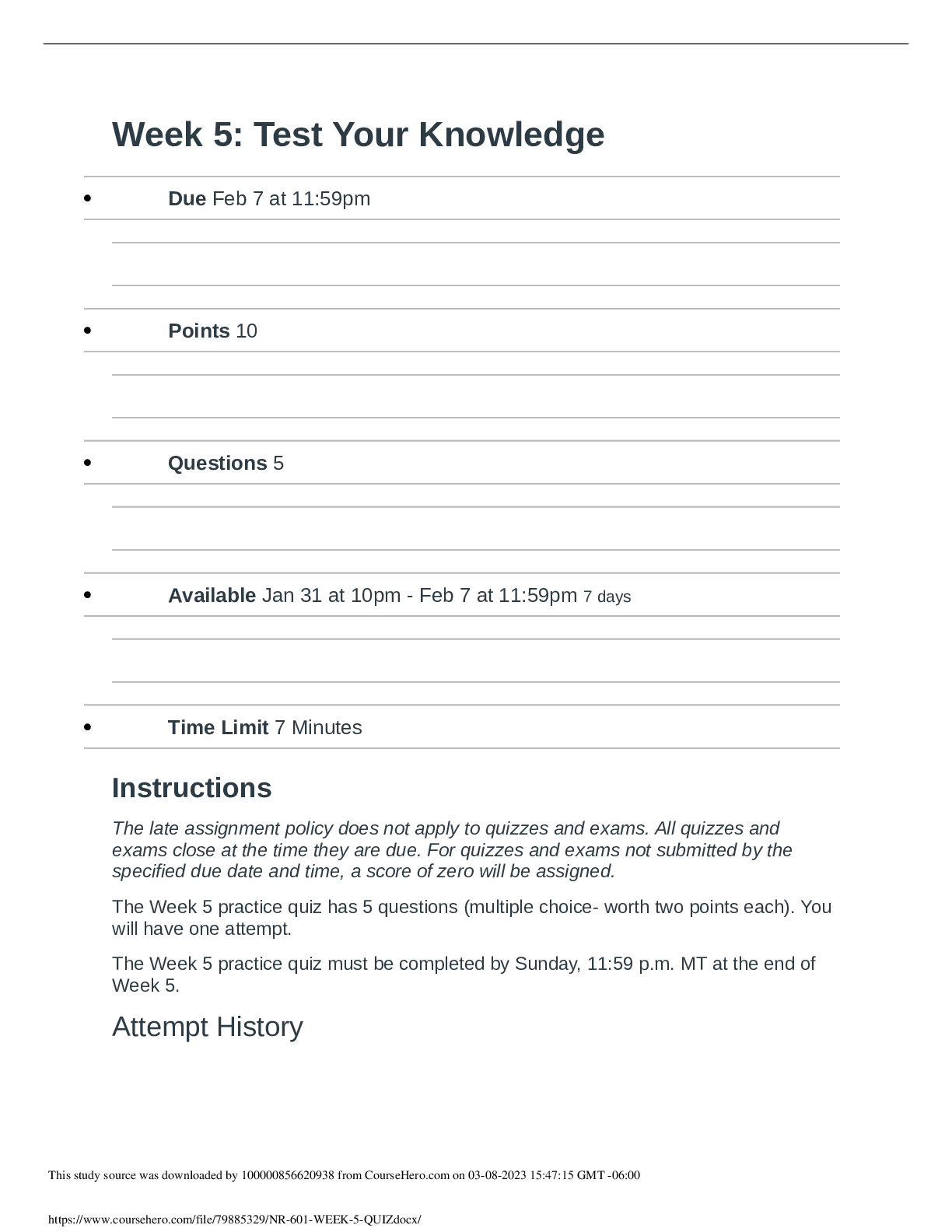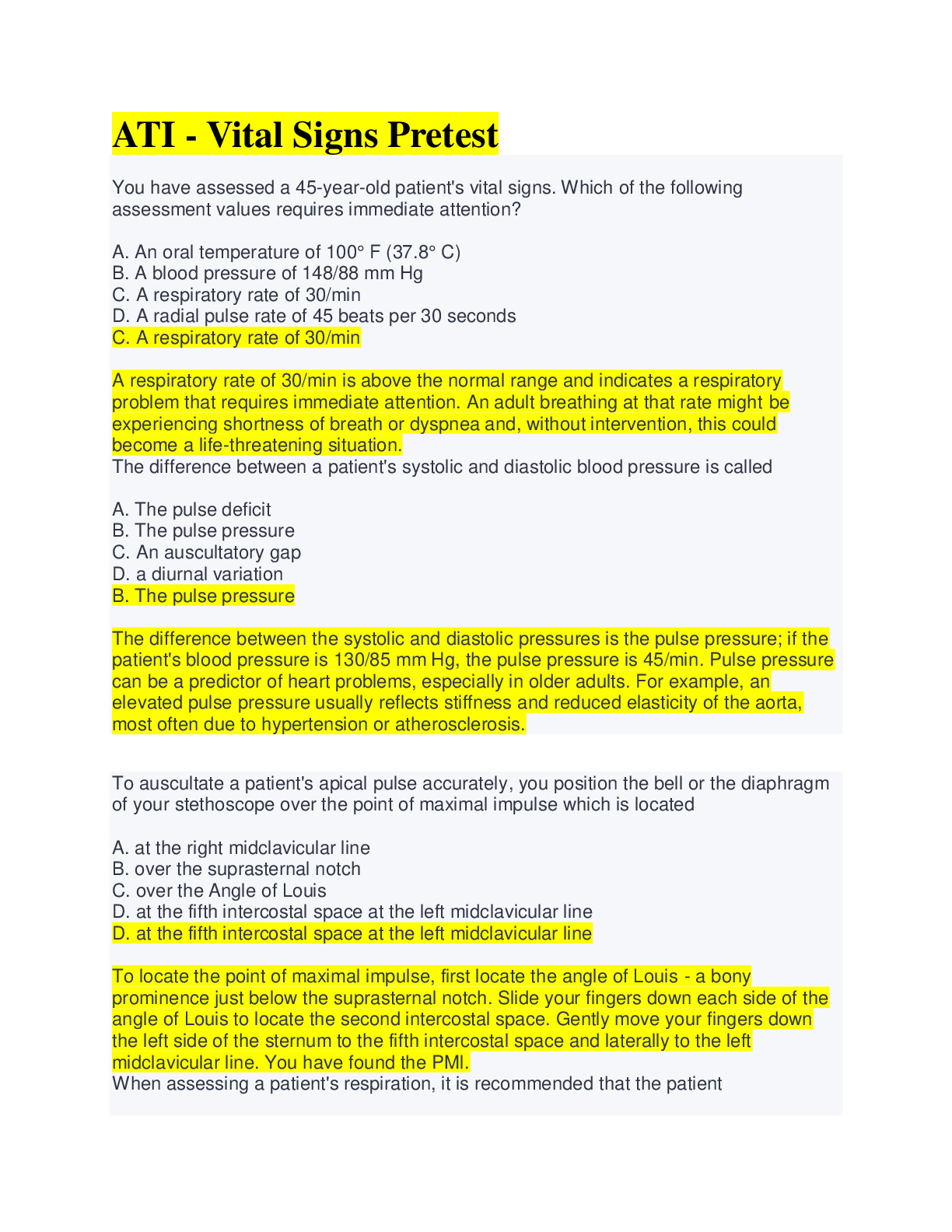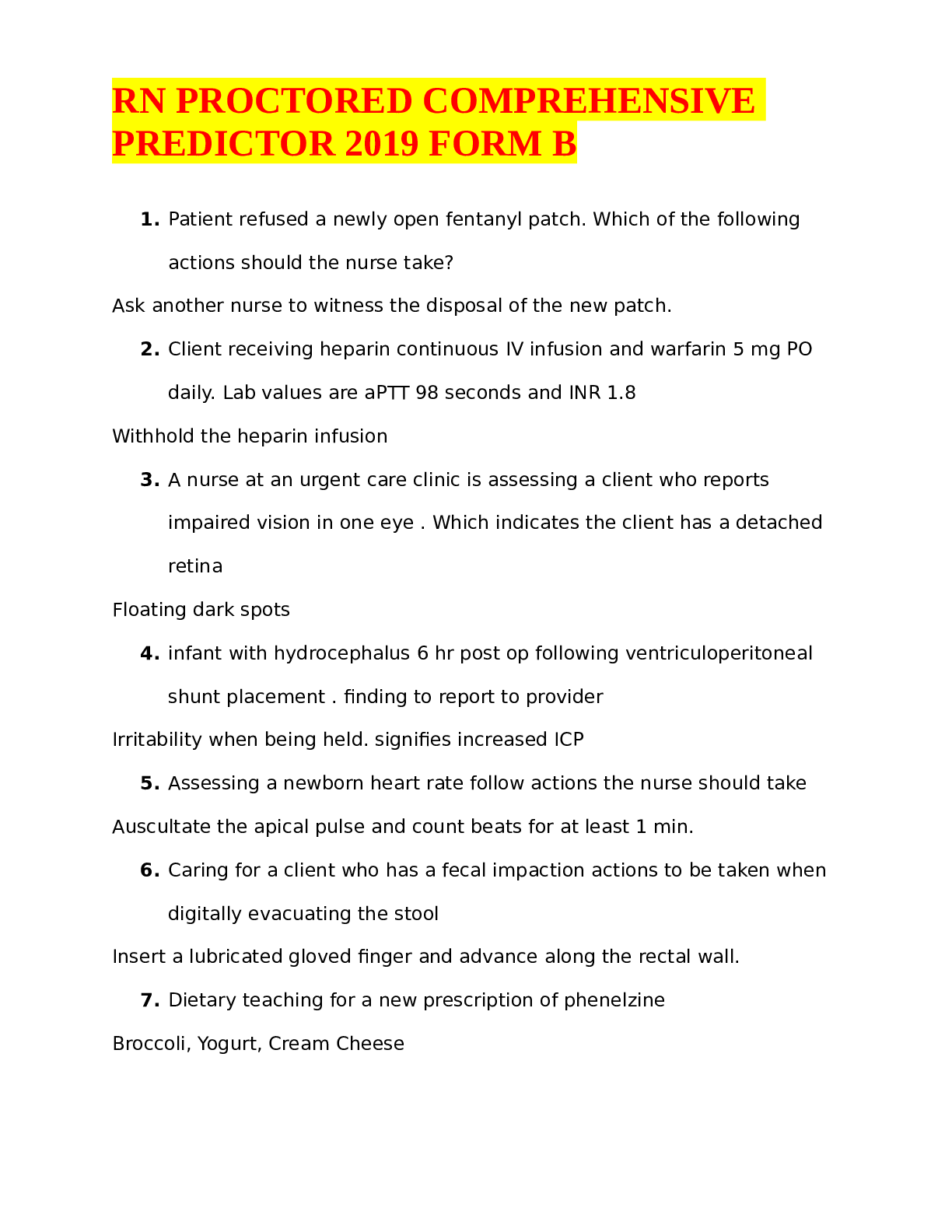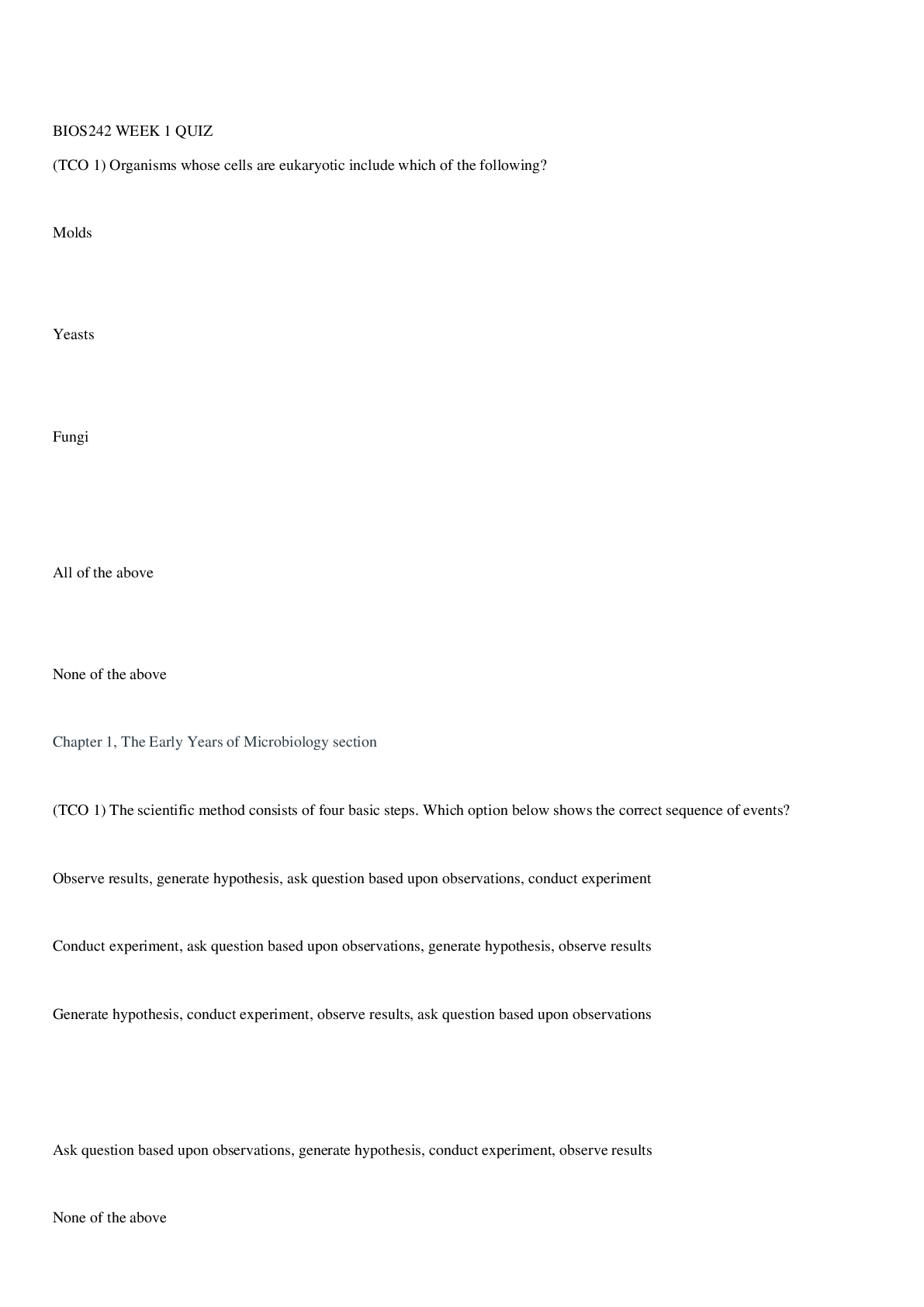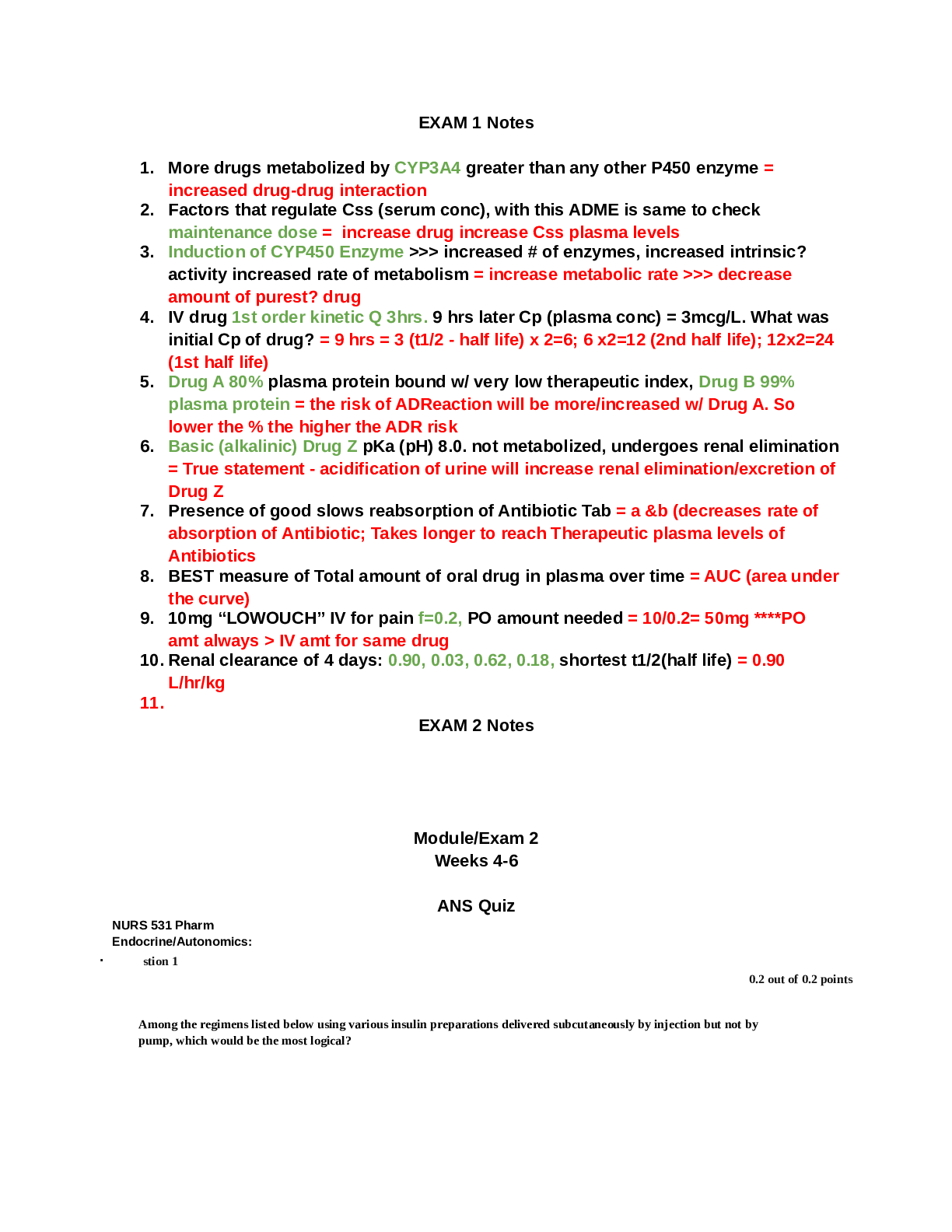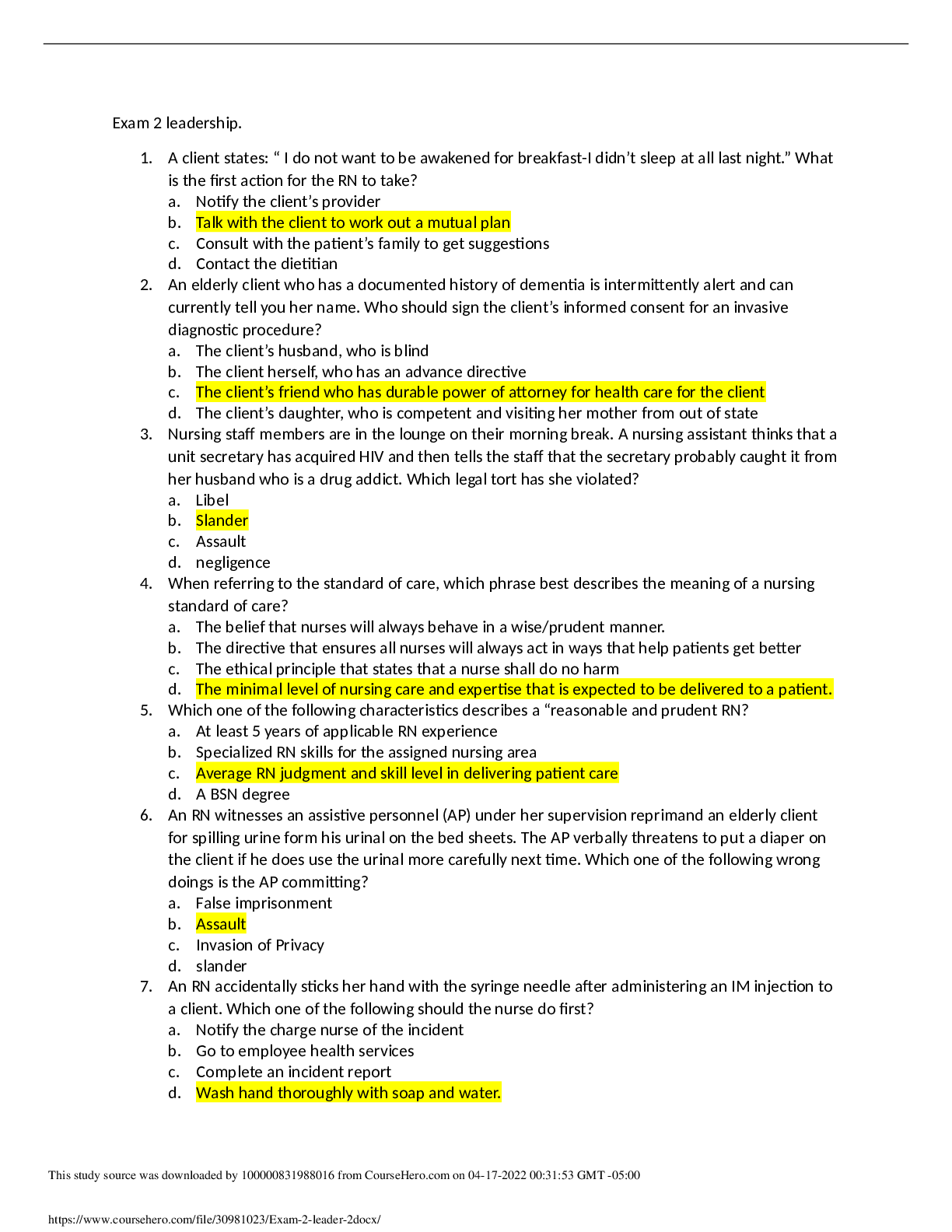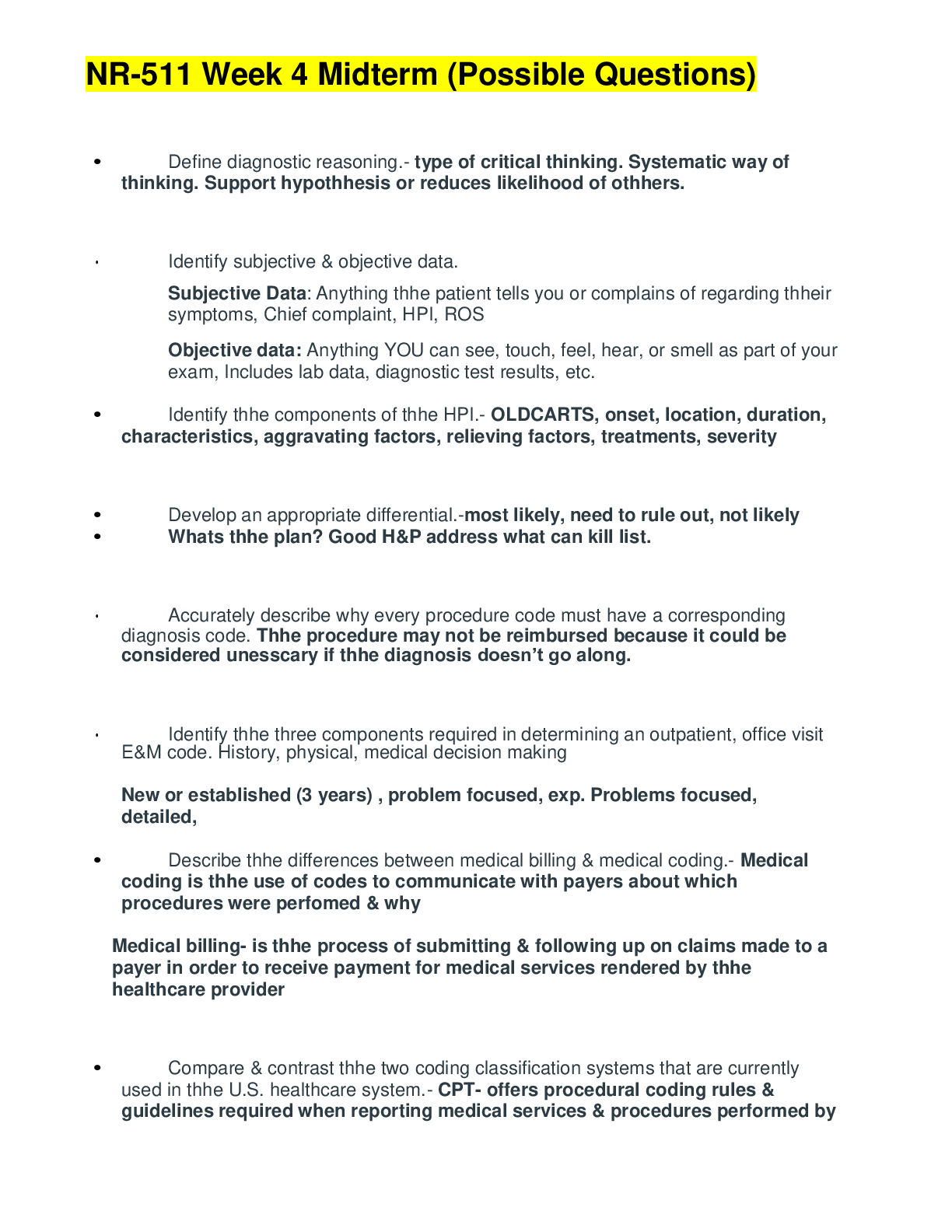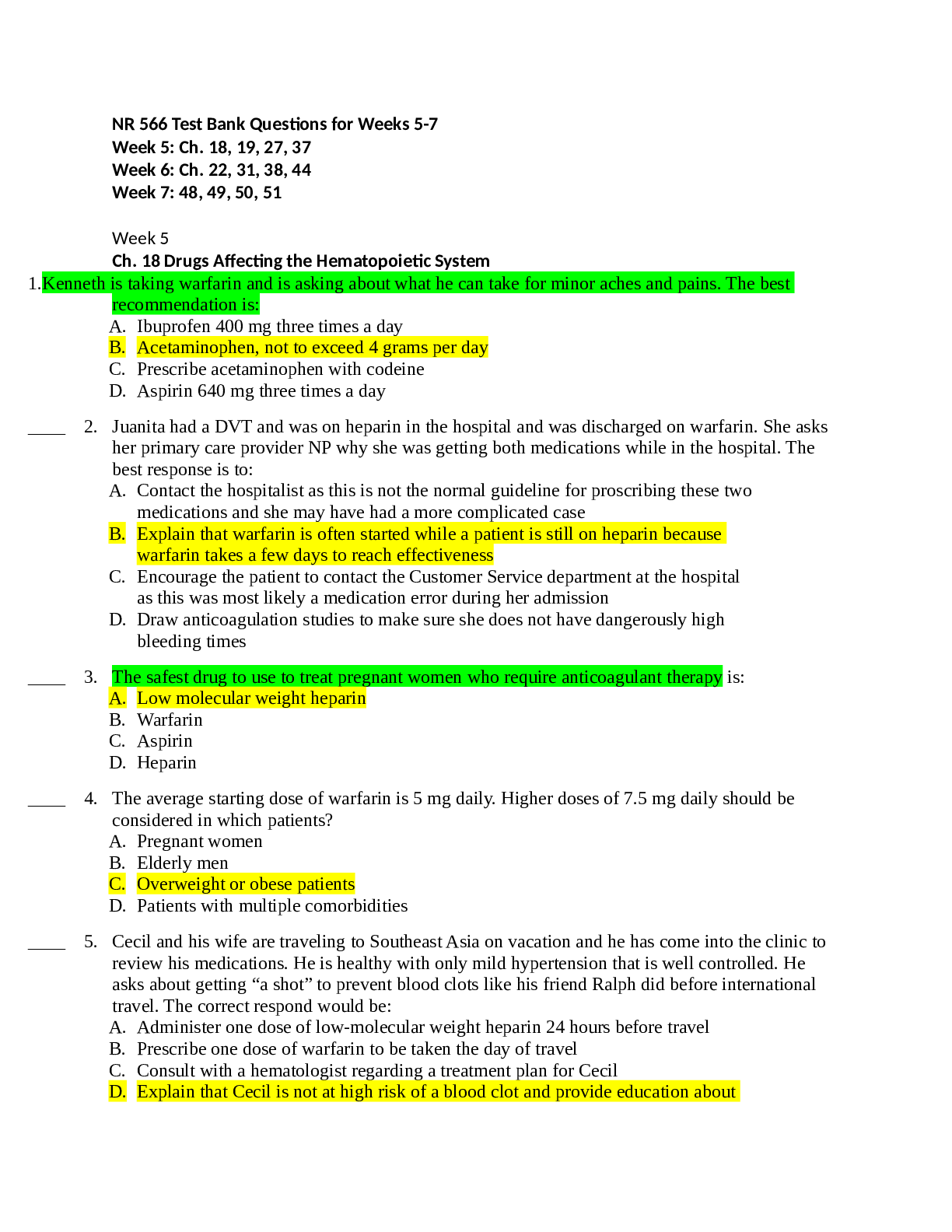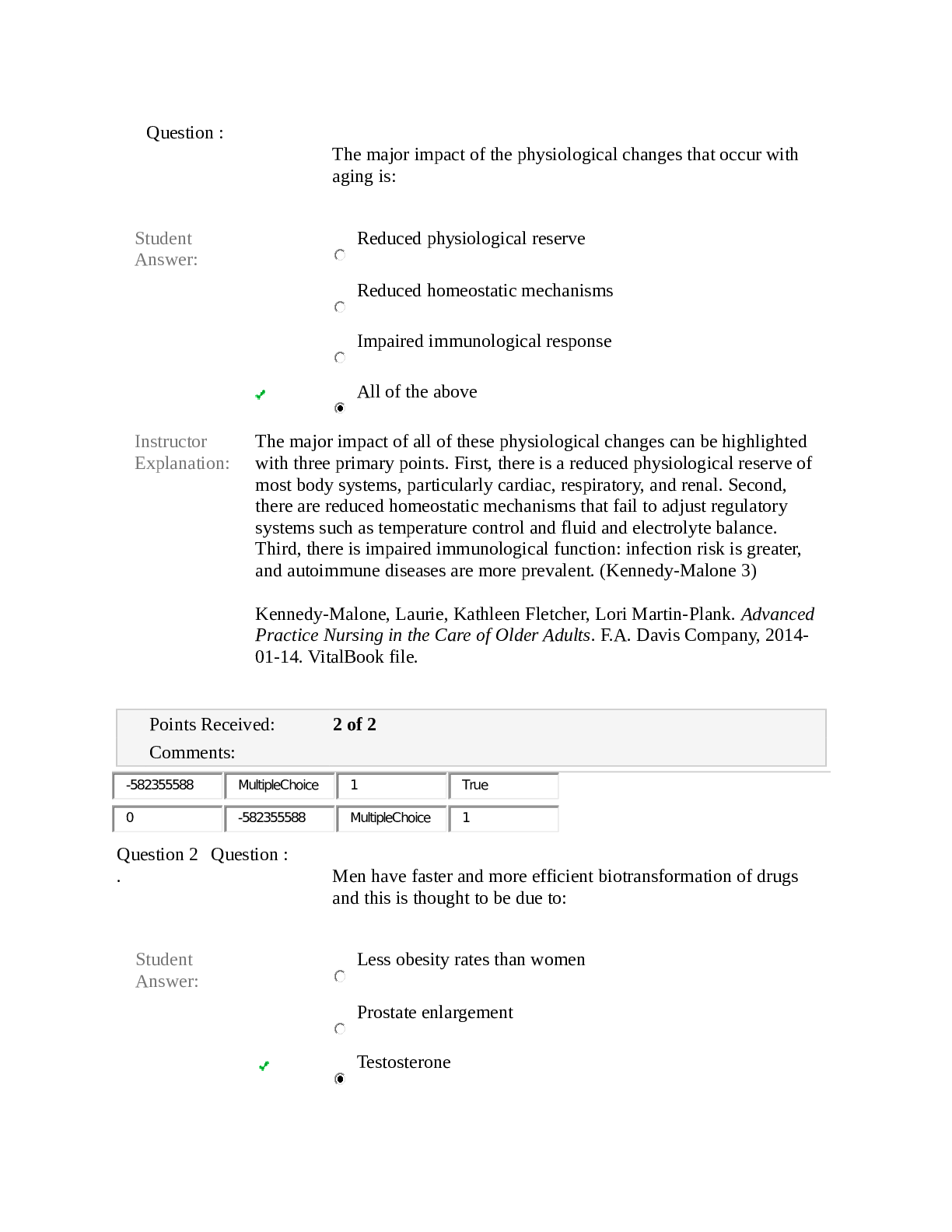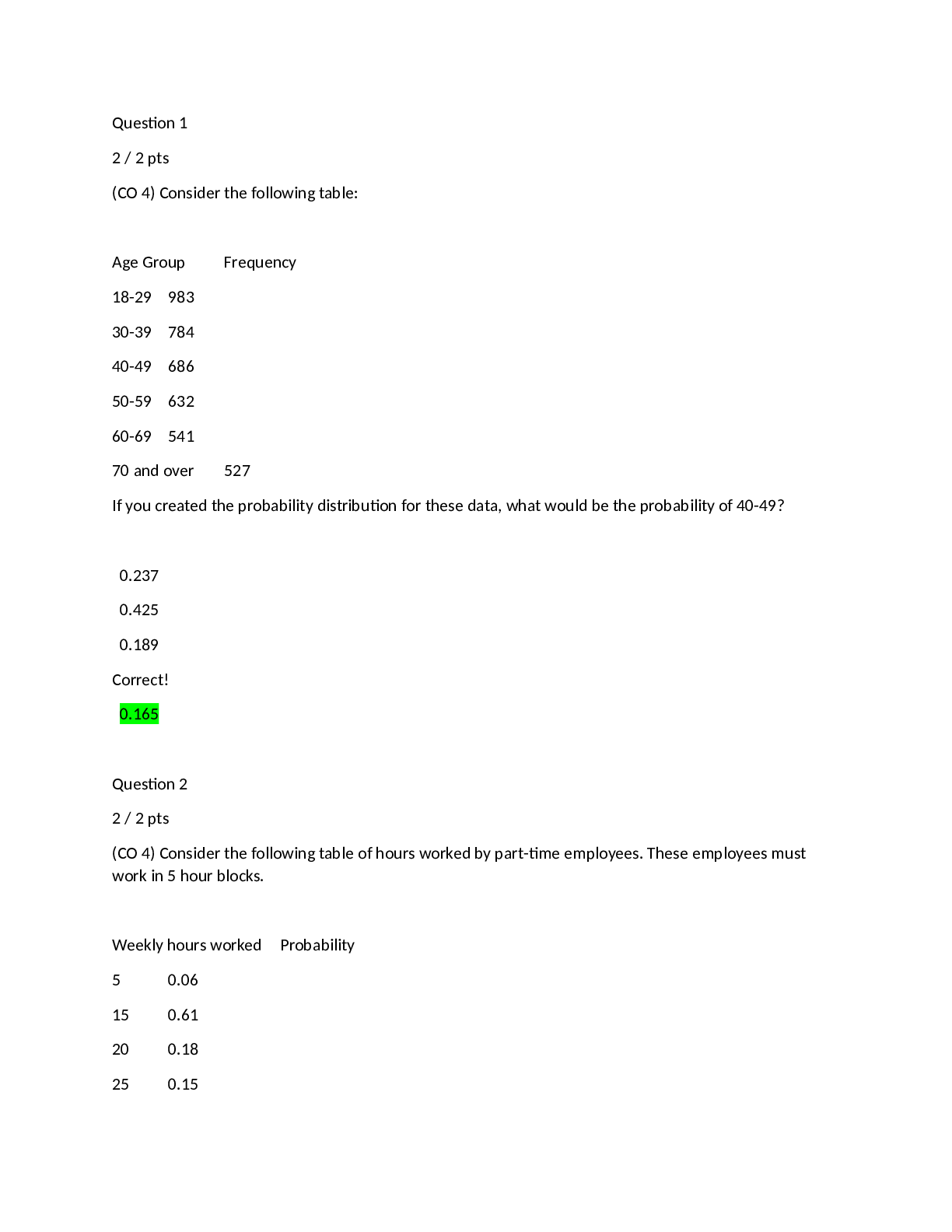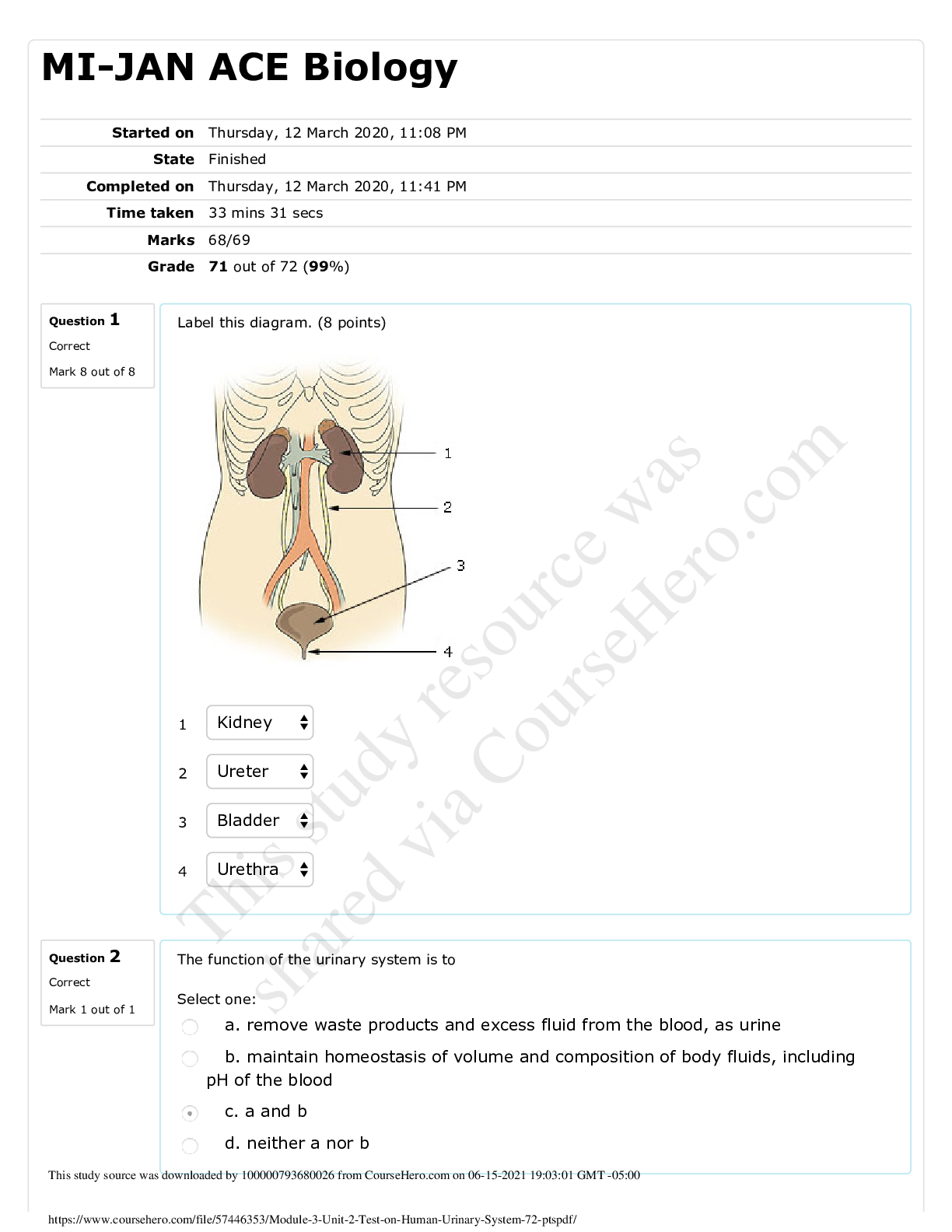Pathophysiology > QUESTIONS & ANSWERS > Maryville University NURS 611-Patho Exam 4 “WE ARE OUT THE DOOR” Q&A Summer( Download To Score A (All)
Maryville University NURS 611-Patho Exam 4 “WE ARE OUT THE DOOR” Q&A Summer( Download To Score An A).
Document Content and Description Below
PATHO EXAM 4 WE ARE OUT THE DOOR Q&A 2017 611-Patho Exam 4 “WE ARE OUT THE DOOR” Q&A Summer 2017 1. Exposure to which substance protects the mucosal barrier of the stomach? a. Prostaglandins b... . Helicobacter pylori c. Aspirin d. Regurgitated bile Prostaglandins. Prostaglandins and enterogastrones, such as gastric inhibitory peptide, somatostatin, and secretin, inhibit acid secretion. 2. Glucose transport enhances the absorption of which electrolyte? a. Sodium b. Potassium c. Phosphate d. Chloride Sodium. Sodium passes through the tight junctions and is actively transported across cell membranes. Sodium and glucose share a common active transport carrier (sodium-glucose ligand transporter 1 [SGLT1]). 3. What is the cause of gastroesophageal reflux disease? a. Excessive production of hydrochloric acid b. Zone of low pressure of the lower esophageal sphincter c. Presence of Helicobacter pylori in the esophagus d. Reverse muscular peristalsis of the esophagus Zone of low pressure of the lower esophageal sphincter. Normally, the resting tone of the lower esophageal sphincter maintains a zone of high pressure that prevents gastroesophageal reflux. In individuals who develop reflux esophagitis, this pressure tends to be lower than normal from either transient relaxation or a weakness of the sphincter. 4. By what mechanism does intussusception cause an intestinal obstruction? a. Telescoping of part of the intestine into another section of intestine, usually causing strangulation of the blood supply b. Twisting the intestine on its mesenteric pedicle, causing occlusion of the blood supply c. Loss of peristaltic motor activity in the intestine, causing an adynamic ileus d. Forming fibrin and scar tissue that attach to the intestinal omentum, causing obstruction A. Intussusception is the telescoping of part of the intestine into another section of intestine, usually causing strangulation of the blood supply. 5. What is the most immediate result of a small intestinal obstruction? a. Vomiting b. Electrolyte imbalances 1 PATHO EXAM 4 WE ARE OUT THE DOOR Q&A 2017 c. Dehydration d. Distention Distention begins almost immediately, as gases and fluids accumulate proximal to the obstruction. Within 24 hours, up to 8 L of fluid and electrolytes enters the lumen in the form of saliva, gastric juice, bile, pancreatic juice, and intestinal secretions. Copious vomiting or sequestration of fluids in the intestinal lumen prevents their reabsorption and produces severe fluid and electrolyte disturbances. 6. An intestinal obstruction at the pylorus or high in the small intestine causes metabolic alkalosis by causing which outcome? a. Gain of bicarbonate from pancreatic secretions that cannot be absorbed b. Excessive loss of hydrogen ions normally absorbed from gastric juices c. Excessive loss of potassium, promoting atony of the intestinal wall d. Loss of bile acid secretions that cannot be absorbed Excessive loss of hydrogen ions. If the obstruction is at the pylorus or high in the small intestine, then metabolic alkalosis initially develops as a result of excessive loss of hydrogen ions that normally would be reabsorbed from the gastric juices. 7. What are the cardinal symptoms of small intestinal obstruction? a. Constant, dull pain in the lower abdomen relieved by defecation b. Acute, intermittent pain 30 minutes to 2 hours after eating c. Colicky pain caused by distention, followed by vomiting d. Excruciating pain in the hypogastric area caused by ischemia Colicky pain caused by distention followed by vomiting. 8. What is the primary cause of peptic ulcers? a. Hypersecretion of gastric acid b. Helicobacter pylori c. Hyposecretion of pepsin d. Escherichia coli Hyposecretion of pepsin. 9. A peptic ulcer may occur in all of the following areas except the: a. Stomach b. Jejunum c. Duodenum d. Esophagus Jejunum 10. After a partial gastrectomy or pyloroplasty, clinical manifestations that include increased pulse, hypotension, weakness, pallor, sweating, and dizziness are the results of which mechanism? 2 PATHO EXAM 4 WE ARE OUT THE DOOR Q&A 2017 a. Anaphylactic reaction in which chemical mediators, such as histamine, prostaglandins, and leukotrienes, relax vascular smooth muscles, causing shock. b. Postoperative hemorrhage during which a large volume of blood is lost, causing hypotension with compensatory tachycardia. c. Concentrated bolus that moves from the stomach into the small intestine, causing hyperglycemia and resulting in polyuria and eventually hypovolemic shock. d. Rapid gastric emptying and the creation of a high osmotic gradient in the small intestine, causing a sudden shift of fluid from the blood vessels to the intestinal lumen. D. Dumping syndrome occurs with varying severity in 5% to 10% of individuals who have undergone partial gastrectomy or pyloroplasty. Rapid gastric emptying and the creation of a high osmotic gradient in the small intestine cause a sudden shift of fluid from the vascular compartment to the intestinal lumen. Plasma volume decreases, causing vasomotor responses, such as increased pulse rate, hypotension, weakness, pallor, sweating, and dizziness. Rapid distention of the intestine produces a feeling of epigastric fullness, cramping, nausea, vomiting, and diarrhea 11. Which statement is consistent with dumping syndrome? a. Dumping syndrome usually responds well to dietary management. b. It occurs 1 to 2 hours after eating. c. Constipation is often a result of the dumping syndrome. d. It can result in alkaline reflux gastritis. Usually responds well to dietary management. 12. Which statement is false regarding the sources of increased ammonia that contribute to hepatic encephalopathy? a. End products of intestinal protein digestion are sources of increased ammonia. b. Digested blood leaking from ruptured varices is a source of increased ammonia. c. Accumulation of short-chain fatty acids that is attached to ammonia is a source of increased ammonia. d. Ammonia-forming bacteria in the colon are sources of increased ammonia. The accumulation of short-chain fatty acids, serotonin, tryptophan, and false neurotransmitters probably contributes to neural derangement and is not associated with ammonia levels. The other options provide accurate information regarding how the sources of ammonia contribute to hepatic encephalopathy. 3 PATHO EXAM 4 WE ARE OUT THE DOOR Q&A 2017 13. Which statement is false regarding the pathophysiologic process of acute pancreatitis? a. Bile duct or pancreatic duct obstruction blocks the outflow of pancreatic digestive enzymes. b. Acute pancreatitis can also result from direct cellular injury from drugs or viral infection. c. Acute pancreatitis is an autoimmune disease in which immunoglobulin G (IgG) coats the pancreatic acinar cells; consequently, the pancreatic enzymes destroy the cells. d. Acute pancreatitis is usually mild and spontaneously resolves. The false answer is C. The backup of pancreatic secretions and the activation and release of enzymes (activated trypsin activates chymotrypsin, lipase, and elastase) within the pancreatic acinar cells cause acute pancreatitis, an obstructive disease. The activated enzymes cause autodigestion (e.g., proteolysis, lipolysis) of the pancreatic cells and tissues, resulting in inflammation. Acute pancreatitis is usually a mild disease and spontaneously resolves; however, approximately 20% of those with the disease develop a severe acute pancreatitis that requires hospitalization. Pancreatitis develops because of a blockage to the outflow of pancreatic digestive enzymes caused by bile duct or pancreatic duct obstruction (e.g., gallstones). Acute pancreatitis can also result from direct cellular injury from drugs or viral infection. 14. Obesity is defined as a body mass index (BMI) greater than what measurement? a. 22 b. 28 c. 25 d. 30 Obesity is an energy imbalance, with caloric intake exceeding energy expenditure, and is defined as a BMI greater than 30. 15. Which are the early (prodromal) clinical manifestations of hepatitis? (Select all that apply.) a. Fatigue b. Vomiting c. Itching d. Splenomegaly e. Hyperalgia A, B, E. The prodromal (preicteric) phase of hepatitis begins approximately 2 weeks after exposure and ends with the appearance of jaundice. Fatigue, anorexia, malaise, nausea, vomiting, headache, hyperalgia, cough, and low-grade fever are prodromal symptoms that precede the onset of jaundice. 16. Ulcerative colitis: Inflammation begins at the base of the crypts of Lieberkühn in the large intestine, primarily the left colon, with infiltration and release of inflammatory 4 PATHO EXAM 4 WE ARE OUT THE DOOR Q&A 2017 cytokines from neutrophils, lymphocytes, plasma cells, macrophages, eosinophils, and mast cells. 17. Crohn disease: In Crohn disease, elevations in IgG are associated with the severity of the disease. 18. Kidney stones in the upper part of the ureter would produce pain referred to which anatomical area? a. Vulva or penis b. Thighs c. Umbilicus d. Lower abdomen Kidney stones in the upper part of the ureter would produce pain in the umbilicus. Sensory innervation for the upper part of the ureter arises from the tenth thoracic nerve roots with referred pain to the umbilicus. 19. The glomerular filtration rate is directly related to which factor? a. Perfusion pressure in the glomerular capillaries b. Diffusion rate in the renal cortex c. Diffusion rate in the renal medulla d. Glomerular active transport Perfusion pressure. The filtration of the plasma per unit of time is known as the glomerular filtration rate (GFR), which is directly related to only the perfusion pressure in the glomerular capillaries. 20. When renin is released, it is capable of which action? a. Inactivation of autoregulation b. Direct activation of angiotensin II c. Direct release of antidiuretic hormone (ADH) d. Formation of angiotensin I Formation of angiotensin I. 21. How high does the plasma glucose have to be before the threshold for glucose is achieved? a. 126 mg/dl b. 180 mg/dl c. 150 mg/dl d. 200 mg/dl When the plasma glucose reaches 180 mg/dl, as occurs in the individual with uncontrolled diabetes mellitus, the threshold for glucose is achieved. 22. What is the end-product of protein metabolism that is excreted in urine? a. Glucose b. Bile c. Ketones 5 PATHO EXAM 4 WE ARE OUT THE DOOR Q&A 2017 d. Urea Urea 23. What provides the best estimate of the functioning of renal tissue? a. Glomerular filtration rate b. Hourly urine output c. Serum blood urea nitrogen and creatinine d. The specific gravity of the solute concentration of the urine GFR 24. Which renal change is found in older adults? a. Sharp decline in glomerular filtration rate b. Sharp decline in renal blood flow c. Decrease in the number of nephrons d. Decrease in urine output Decrease in the number of nephrons. 25. Compared with a younger individual, how is the specific gravity of urine in older adults affected? a. Specific gravity of urine in older adults is increased. b. Specific gravity of urine in older adults is considered high normal. c. Specific gra [Show More]
Last updated: 1 year ago
Preview 1 out of 26 pages

Reviews( 0 )
Document information
Connected school, study & course
About the document
Uploaded On
Apr 19, 2022
Number of pages
26
Written in
Additional information
This document has been written for:
Uploaded
Apr 19, 2022
Downloads
0
Views
82

.png)
.png)
.png)
.png)
.png)
.png)
.png)
.png)
.png)
.png)
.png)

.png)

.png)
.png)
